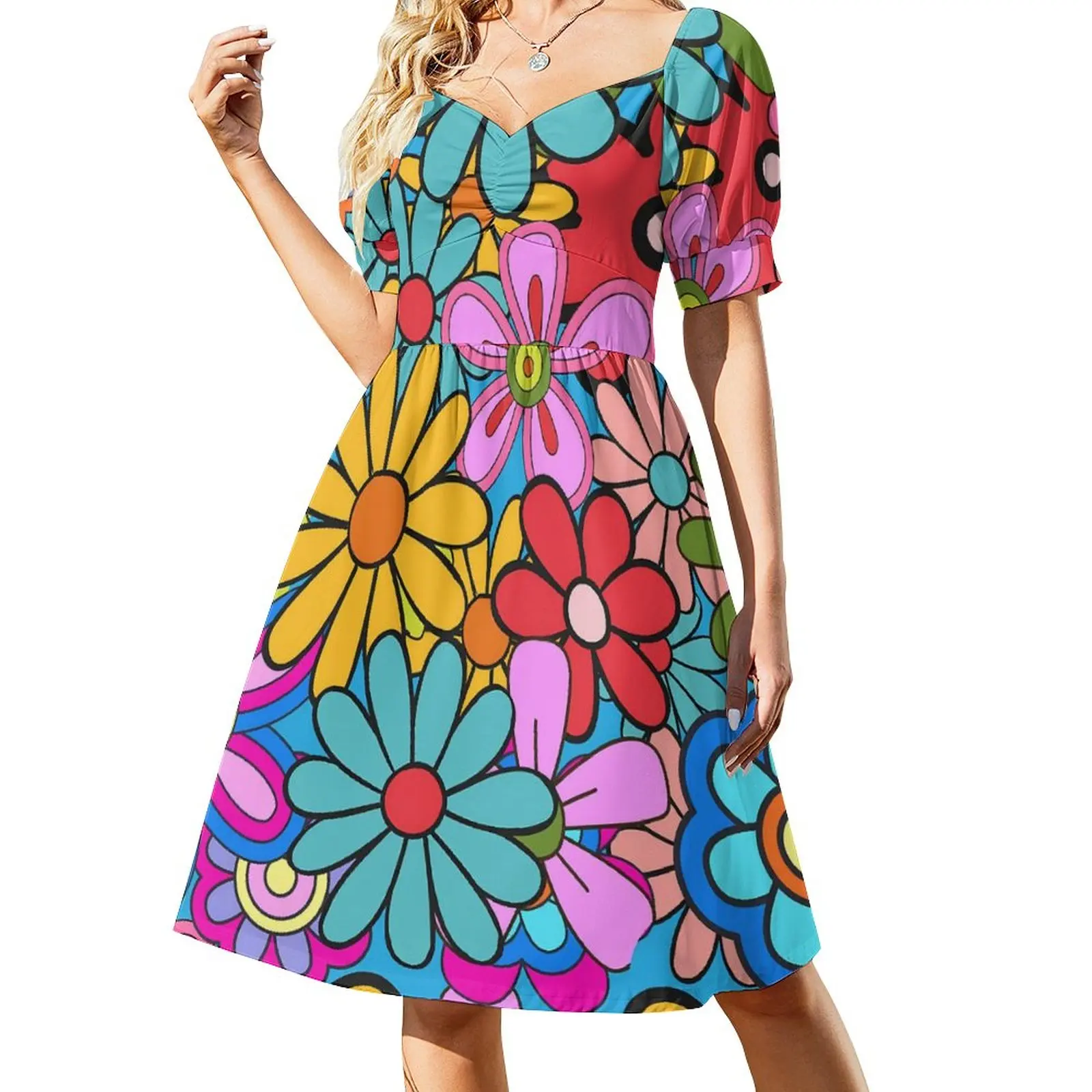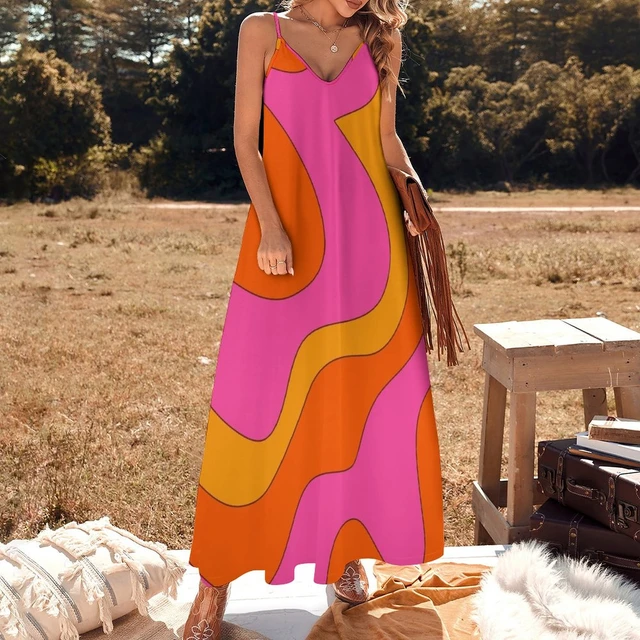Contents
 Introduction:
Introduction:
The fashion of the 1970s was a vibrant and transformative era, marked by a blend of cultural influences and a spirit of individuality. 70s dress styles reflected the sociopolitical changes of the time, embracing freedom of expression and self-expression through fashion. In this comprehensive article, we will delve into the fashion trends and iconic styles of 70s dress. From disco glamour and bohemian chic to bold colors and psychedelic prints, the fashion of the 1970s left an indelible mark on the world of style.
Bohemian and Hippie Fashion
Flowing Silhouettes:
In the early 70s, bohemian fashion emphasized loose, flowing silhouettes, inspired by the counterculture movement.
Maxi dresses, peasant blouses, and flared pants were popular choices, reflecting a free-spirited and relaxed aesthetic.
Natural and Earthy Tones:
Earthy tones like browns, oranges, and deep reds dominated the color palette of bohemian fashion.
Natural fabrics such as cotton and linen were favored for their comfort and organic feel.
Embroidery and Fringe:
Embroidery and fringe accents added a touch of whimsy and craftsmanship to bohemian dresses.
These details reflected the appreciation for handcrafted elements and ethnic influences.
 Disco and Glamour
Disco and Glamour
Body-Hugging Silhouettes:
Disco fashion in the late 70s embraced a more fitted and glamorous aesthetic, emphasizing the body’s curves.
Dresses with plunging necklines, halter tops, and high slits became popular choices for dancefloors.
Metallic Fabrics:
Disco fashion often featured shimmering and reflective materials such as lamé and sequins.
Silver, gold, and metallic shades added a sense of glamour and drama to disco dresses.
Bold Colors and Prints:
Disco fashion embraced bold and vibrant colors like electric blue, fuchsia, and neon hues.
Psychedelic prints, geometric patterns, and abstract motifs embodied the disco spirit.
 Here are some features of 70s cocktail dresses:
Here are some features of 70s cocktail dresses:
Silhouette:
The 1970s saw a shift towards looser and flowy silhouettes compared to the more form-fitting styles of the previous decades. Cocktail dresses often featured a relaxed and draped silhouette that emphasized comfort and movement.
Maxi Length:
Maxi-length cocktail dresses were popular in the 70s. These floor-length or ankle-length dresses exuded a sense of glamour and sophistication. They were often made from luxurious fabrics like chiffon, silk, or velvet.
Neckline Variety:
The 1970s offered a range of neckline styles for cocktail dresses. Popular choices included halter necklines, deep V-necklines, sweetheart necklines, and one-shoulder designs. These neckline styles added a touch of femininity and allure.
Bold Prints and Colors:
Vibrant prints and bold colors were a hallmark of 70s fashion. Cocktail dresses often featured eye-catching patterns, such as psychedelic prints, geometric designs, or floral motifs. Popular colors included deep jewel tones, earthy hues, or vibrant shades like orange, green, and purple.
Flowing Sleeves and Ruffles:
Many cocktail dresses in the 1970s featured flowing sleeves like bell sleeves or butterfly sleeves. Ruffles and frills were also seen on sleeves, necklines, or skirts, adding a romantic and whimsical touch to the dresses.
Empire Waistlines:
Empire waistlines, characterized by a high waistline just below the bust, were popular in this era. They created a flattering and elongated silhouette, emphasizing the upper body and giving a bohemian and ethereal feel to the cocktail dress.
Accessory and Embellishments:
Cocktail dresses of the 70s often included bold accessories and embellishments. This could include oversized bows, beaded accents, sequins, or metallic detailing, which added glamour and sparkle to the overall look.
Wrap Dresses:
Wrap dresses were another popular style in the 70s. They featured a wrap-around design with a tie or belt at the waist, offering a versatile and flattering fit that suited various body types.
These characteristics capture the essence of 70s cocktail dresses, with their loose silhouettes, bold prints, vibrant colors, unique necklines, and attention to detail. These dresses reflected the fashion trends of the era and continue to inspire contemporary designers today.
Iconic 70s Dress Styles
Diane von Furstenberg introduced the iconic wrap dress in the 70s, which became a symbol of female empowerment and timeless style.
The wrap dress featured a flattering silhouette that cinched at the waist and v-neckline, suitable for various body types.
Kaftan Dresses:
Kaftan dresses gained popularity in the 70s, inspired by Middle Eastern and African styles.
Often made from lightweight and flowing fabrics, kaftan dresses were comfortable and exuded an air of exoticism.
Pinafore Dresses:
Pinafore dresses, also known as jumper dresses, were a versatile and youthful style embraced by the 70s fashion.
Layered over blouses or turtlenecks, pinafores offered an effortless and preppy look.
 Fashion Influences and Legacy of 70s Dress
Fashion Influences and Legacy of 70s Dress
Cultural Influences:
70s dress styles drew inspiration from various cultural influences, including the feminist movement, global travel, disco music, and the war in Vietnam.
This amalgamation of cultures and ideas resulted in a diverse and dynamic fashion landscape.
Enduring Fashion Trends:
Several 70s fashion trends continue to influence contemporary style, such as bohemian fashion and bold prints.
Elements like maxi dresses, flared pants, and wrap dresses have stood the test of time, remaining relevant and trendy.
The Influence of Celebrities:
Fashion icons of the 70s, such as Bianca Jagger, Cher, and Farrah Fawcett, played significant roles in shaping the fashion trends of the decade.
Their iconic looks and personal style continue to inspire fashion today.
Here are a few possible disadvantages:
While the 1970s brought about many unique fashion trends, including cocktail dresses, there were some potential drawbacks associated with 70s dresses. Here are a few possible disadvantages:
Fabric Quality: Some cocktail dresses of the 1970s were made from lower-quality synthetic fabrics that may have lacked durability and longevity. These materials could be prone to pilling, tearing, or losing shape over time.
Maintenance and Care: Certain fabrics and designs of 70s dresses required special care and attention. Delicate fabrics like chiffon or silk might have required professional dry cleaning, making them more high-maintenance compared to other materials.
Sizing Limitations: Size inclusivity was not as prominent in fashion during the 70s as it is today. Finding a well-fitting cocktail dress, especially for individuals with different body types or outside of standard sizing norms, might have been more challenging.
Limited Mobility: Some of the loose and flowing styles of 70s cocktail dresses, while fashionable, could restrict movement to some extent. The ankle-length or floor-length designs, for example, might have required more careful steps and limited freedom of movement compared to shorter dress lengths.
Fit and Proportions: The loose and draped silhouettes, while comfortable and trendy, might not have flattered every body type. Those with petite frames or who preferred a more fitted look might have found it more difficult to find a cocktail dress that catered to their desired fit and proportions.
Dated Style: As with any fashion era, the characteristics of 70s dresses can appear dated or may not align with current trends and personal style preferences. Some people might view the distinct features of 70s cocktail dresses as less appealing or not in line with their modern aesthetic.
It’s important to note that these potential drawbacks are not true for every 70s dress, as individual designs and manufacturing quality varied. Additionally, the perceived disadvantages of 70s dresses are subjective and can vary based on personal preferences and opinions.
 Conclusion:
Conclusion:
70s dress styles were a reflection of the cultural movements and fashion revolutions of an era. From the bohemian spirit to disco glamour, the fashion trends of the 1970s created an unmistakable and influential aesthetic. The enduring legacy of 70s dress is still seen in today’s fashion, as elements such as flowing silhouettes, bold prints, and iconic designs continue to captivate and inspire. The fashion of the 70s serves as a reminder of the transformative power of self-expression through style and remains an indelible part of fashion history.
